A preliminary sustainability assessment of innovativerainwater harvesting for residential properties in the UK
2014-09-06PeterMelvilleShreeveSarahWardDavidButler
Peter Melville-Shreeve Sarah Ward David Butler
(Centre for Water Systems, University of Exeter, Exeter, EX4 4QF, UK)
A preliminary sustainability assessment of innovativerainwater harvesting for residential properties in the UK
Peter Melville-Shreeve Sarah Ward David Butler
(Centre for Water Systems, University of Exeter, Exeter, EX4 4QF, UK)
Rainwater harvesting (RWH) has yet to see significant uptake in UK households, primarily due to a lack of innovation in residential RWH system types. This paper presents the results of preliminary investigations into a range of traditional and innovative residential-scale RWH systems. These systems are examined using a patent application search, informal interviews with industry professionals, cost-benefit analysis and a simple multi criteria analysis (MCA). The latter examines the sustainability of the systems, based on a priori social, economic and environmental criteria. Two of the innovative systems are subject to a more detailed analysis and benchmarked against a traditional system. Results of the MCA indicate that the innovative RWH systems achieve better sustainability scores than the traditional RWH with a lower capital cost. Further research is focused on monitoring the identified systems to generate empirical datasets, in order to undertake the WLC/LCAs and to identify challenges associated with installation.
innovation; multi criteria analysis; rainwater harvesting; residential; sustainability; water efficiency
Rainwater harvesting (RWH) at residential properties in the UK remains a novel concept, with the market over the previous decade largely led by new build installations. At present approximately 5 000 installations are undertaken each year, compared to the estimated 100 000 installations built annually in Germany[1]. Consequently, the benefits of implementing RWH in water demand management and source control applications have yet to be fully examined in the UK’s housing sector. It is considered likely that with improved technological innovation, reduced capital costs and changing water management policy, that the RWH industry in the UK will continue to grow[2]. It is recognized that significant innovations in both commercial and residential rainwater harvesting can be observed throughout the world. However, this paper, will only consider the UK’s residential RWH sector.
1 Background
In the context of this paper, RWH involves the capture and storage of rainwater for reuse within a residential setting. Traditional UK RWH systems involve the capture and conveyance of roof water into a below-ground storage tank. A submersible pump supplies rainwater into the property. This provides an off-grid, non-potable water supply for use within the property’s WC’s, washing machines and gardens[2].
The design of RWH systems is steered by the methods included in standard BS 8515:2009[3]. The introduction of this British Standard, the growth of a number of UK-based RWH companies and on-going legislative and sustainability drivers, have seen the RWH sector emerge as a developing market in the previous decade[1]. Growth in the sector has been identified largely within the new build market and has been driven by the requirements of the code for sustainable homes (CSH)[4]. The CSH guides the construction of new residential properties in England and Wales and sets targets, which encourage property developers to install technologies that lower the overall impact of the building in terms of energy and water use. Furthermore, a number of local planning authorities in the England and Wales use planning conditions that encourage RWH[5].
Retrofit of RWH systems has yet to see significant growth. This is due largely to long payback periods. Financial savings for a typical residential RWH system located in Birmingham within the supply area of water service provider Severn Trent Water, would be approximately 50 GBP/a based on water costs of 1.52 GBP/m3[6]. Additional savings can also be achieved through reduced wastewater charges.
Appropriately designed RWH systems may present sustainability benefits through reducing the demand on centralized potable water resources, attenuating flood flows within surface water systems[7]; and increasing the resilience of water infrastructure. In England some water resources are significantly over abstracted[8], particularly in the south-east where annual average rainfall can be limited to approximately 600 mm/a and where the population density and economic activity are the greatest[3].
Recent information, presented by the England and Wales’ water regulator OFWAT, suggests that the future availability of raw water resources for centralized water networks may reduce as tighter regulation is imposed through tools such as the Abstraction Incentive Mechanism[8]. This regulation is being proposed to reduce unsustainable over-abstraction which can cause rivers to dry out, particularly in the south-east of the UK as exemplified by the River Kennet in 2012[9]. The large-scale uptake of RWH technologies could potentially assist in reducing centralized water abstraction and treatment. Reduced centralized water provision can have significant environmental benefits, which can contribute to the sustainability credentials of RWH under a triple bottom line assessment[10]. Energy savings could also be realized throughout water and wastewater networks, as illustrated in Tab.1.
Tab.1 Potential energy savings and environmental benefits resulting from residential water use reductions via large-scale RWH adoption
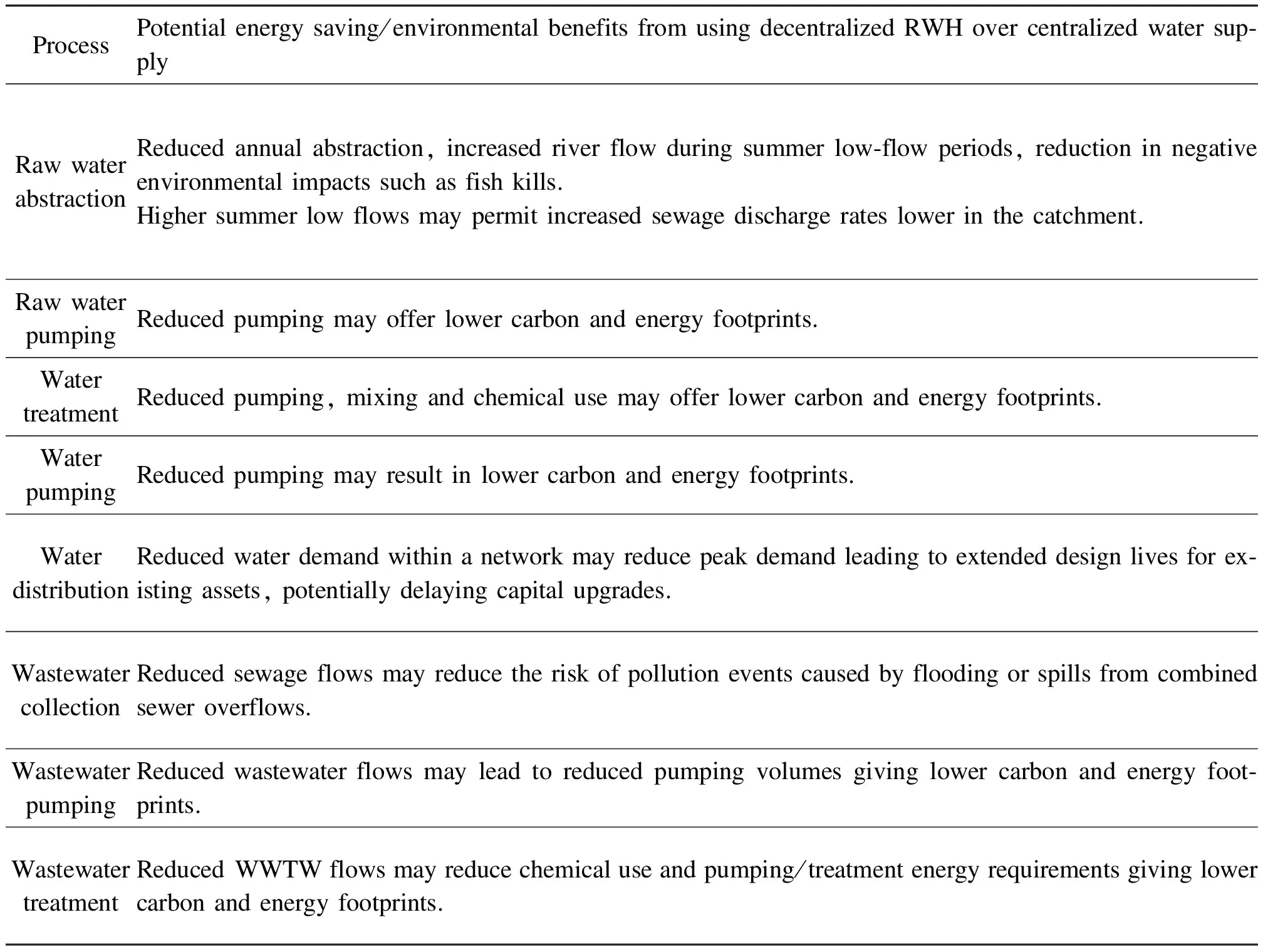
ProcessPotentialenergysaving/environmentalbenefitsfromusingdecentralizedRWHovercentralizedwatersup⁃plyRawwaterabstractionReducedannualabstraction,increasedriverflowduringsummerlow⁃flowperiods,reductioninnegativeenvironmentalimpactssuchasfishkills.Highersummerlowflowsmaypermitincreasedsewagedischargerateslowerinthecatchment.RawwaterpumpingReducedpumpingmayofferlowercarbonandenergyfootprints.WatertreatmentReducedpumping,mixingandchemicalusemayofferlowercarbonandenergyfootprints.WaterpumpingReducedpumpingmayresultinlowercarbonandenergyfootprints.WaterdistributionReducedwaterdemandwithinanetworkmayreducepeakdemandleadingtoextendeddesignlivesforex⁃istingassets,potentiallydelayingcapitalupgrades.WastewatercollectionReducedsewageflowsmayreducetheriskofpollutioneventscausedbyfloodingorspillsfromcombinedseweroverflows.WastewaterpumpingReducedwastewaterflowsmayleadtoreducedpumpingvolumesgivinglowercarbonandenergyfoot⁃prints.WastewatertreatmentReducedWWTWflowsmayreducechemicaluseandpumping/treatmentenergyrequirementsgivinglowercarbonandenergyfootprints.
Additionally, the impacts of climate change and population growth will continue to exert additional pressure on water resources[11]. Tools such as RWH are increasingly being considered, as they have the potential to offer increased resilience within water infrastructure systems through reducing water demand and minimizing wastewater discharges. However, despite the environmental benefits which could potentially be derived from increased RWH uptake, significant financial incentives to install residential RWH are not available. The main financial incentive for implementing RWH is through reducing the cost of the water bill for a given homeowner. The water technology list (WTL) effectively subsidizes some commercial RWH installations by 20%[12]by providing a tax reclaim scheme. The WTL sets out approved water saving products. These can be purchased and installed at business premises and their costs can be offset against the company’s tax bill. At present, no subsidy is available for the residential RWH market[13].
To date, research on the environmental benefits of RWH has been scarce[2]. Without such quantified recognition of the environmental benefits for RWH, the residential RWH market has been driven by
1) For newly constructed buildings: A complex mechanism, based on a number of guidelines, set out in the Code for Sustainable Homes[4], which requires low potable water usage technologies to be incorporated.
2) For retrofit buildings: Environmental motivations of homeowners, such as the desire to lead a low impact lifestyle[14].
2 Innovation in Residential RWH in the UK
In defining sustainability, this study considers the triple bottom line approach put forward by Elkington[10]. This approach builds upon the generally accepted definition of sustainability and takes into account economic, social and environmental factors, rather than simply financial sustainability[15]. Fig.1 illustrates a conceptual model that could be used to identify the most sustainable technology available on the RWH market. This study applies this conceptual model to the implementation of a simple multi criteria analysis (MCA), in order to assess existing and innovative RWH systems.

Fig.1 Identifying idealized design point for sustainable RWH
Memon and Butler[16]illustrated that RWH could provide approximately 30% of residential water needs for WC flushing requirements. Furthermore, their study illustrates that where roof area and householder perceptions allow, an additional 20% could be saved using rain water in washing machines. Displacing potable water usage represents the main financial benefit for the installation of residential RWH. It follows that an ideal RWH system should achieve this sustainably and at the lowest cost. As identified in Tab.1, triple bottom line incentives for water service providers to implement RWH are beginning to emerge, in the form of overall reductions in energy use, carbon footprints and pollution events. These factors represent additional tangible benefits and their quantification may drive technological innovation in RWH.
An improved understanding of these factors has driven innovators within the sector to re-conceptualise, adapt or re-design RWH systems in order to deliver lower cost solutions. Capital cost remains the key factor for developers considering environmental technologies, such as RWH. It is estimated that the increased construction costs to achieve CSH level 3 can be up to 5 000 GBP/property, with level 6 costing an additional 37 000 to 47 500 GBP/property[5]. Consequently, unless RWH is mandated by the CSH or equivalent legislation, property developers will seek to avoid the additional capital costs, even where tangible sustainability benefits are achievable.
A key social factor in considering further development of RWH systems, is the desire for people to reduce their overall resource and energy demand on the planet’s resources[17]. Discussions held with RWH installers confirmed that the existing retrofit RWH market is driven by householders who install the systems based on environmental and social benefits. It is considered that this “feel-good” factor represents a significant aspect of the motivation behind the industry’s early adopters who have already installed retrofit RWH systems. Improving the design of RWH systems to minimize capital, energy and carbon costs, while maximizing the water saving benefits, would perhaps encourage the early majority to adopt RWH[2]. Carbon footprinting is a well understood social/environmental concept within the UK. When assessing the carbon footprint of RWH, it is important to review the system’s operational energy requirements. Minimizing operational energy use will minimize the carbon footprint. It is evident that systems that avoid excavation in order to install below ground tanks will also have lower capital carbon footprints than traditional systems. Systems such as those examined by Hardie[18], have demonstrated that consideration of low energy RWH options is now underway.
RWH has perhaps yet to see any direct subsidy program, partly because the direct benefits, as previously identified, have yet to be fully assessed. Consequently, there is limited will at the political level or from water service providers in advocating RWH. The Environment Agency for England and Wales currently advises that RWH should be considered on a site by site basis, as it does not necessarily reduce the total operational energy demand of new development[19]. This factor has driven notable innovations in the RWH sector to reduce the energy consumption of proprietary systems. Looking to the future, innovation in RWH will potentially be driven by one or more of the following mechanisms:
1) Central government recognizes sustainability benefits and incentivizes RWH adoption through policy changes, subsidy or mandating RWH at new developments;
2) Water prices continue to increase and the financial payback period for RWH systems reduces;
3) Water service providers recognize (and are able to quantify and benefit from) the financial and environmental benefits that RWH may present in relation to water distribution and sewerage systems;
4) Technological innovations reduce the capital and whole life costs (WLC) of RWH systems providing an increasingly sustainable RWH option.
To summarize the literature considered above, a series of key factors have been identified as a driving innovation in RWH:
• A need to reduce: Energy use, carbon footprints, pumped flows, the impacts of climate change, flooding, capital costs, maintenance requirements, the use of large plastic tanks, excavation requirements.
• A need to maximize: Sustainable drainage systems (SuDS) benefits such as source control measures, benefits to water quality (both within RWH systems and the wider environment), retrofittability, subsidy, policy and incentivisation tools, RWH as a catchment management tool.
The existing drivers for innovation within the RWH industry have been established and their context considered against the UK’s existing market. Development of RWH systems to meet the drivers has been ongoing over the previous decade as the market continues to develop[1]. The previous discussion has demonstrated that it is desirable to identify forthcoming innovations and to appraise them against the existing traditional RWH systems available. Roebuck et al.[20]demonstrated that a detailed assessment of RWH can be undertaken through implementation of a whole life costing approach, however for innovative systems which have yet to be developed, it is considered that a simpler approach will be necessary. This paper summarizes the initial work undertaken in order to identify and consider these innovative RWH systems.
3 Methodology
In order to explore innovations in RWH systems in the UK, the RWH market was considered through informal interviews with a range of industry professionals. A review of patent applications was also conducted and innovations identified. Further appraisal of traditional and innovative RWH systems was conducted through a capital cost assessment. A multi criteria analysis (MCA) was then used to assess the relative sustainability benefits of two specific innovative RWH systems.
3.1 Patent application search
Patent searches were conducted using the UK Patent website, to ascertain information on potentially innovative RWH systems. The search term was set as “Rainwater AND Harvesting” and a period from 30th January 2008 to 30th January 2013 was reviewed. Each patent application was considered against the factors set out in Section 2. Where potentially beneficial innovations were identified, the concept was put forward for additional consideration and the patent holder was contacted.
3.2 Informal interviews and capital cost assessment
Informal telephone interviews were conducted with participants from four traditional RWH providers and two innovative RWH companies during April 2013. RWH providers were selected following initial discussions at London’s Ecobuild show in March 2013. Each participant was requested to provide:
1) Quotations (Excluding VAT) and specifications for a small and medium size residential RWH residential system;
2) An evidenced estimate for new-build and retrofit installation costs;
3) Details of any special characteristics of their system;
4) Opinions on the barriers to RWH industry growth;
5) Details of recent or forthcoming innovations within the RWH sector.
For each supplier, variations in quality, ease of use and specifications were noted. However, the systems were broadly similar and could therefore be directly compared based on their cost and storage volumes. Other work has successfully been conducted to assess the whole life cost (WLC) of RWH systems[20]. This would be the preferred approach to be adopted as this study is extended. However, the relatively high capital cost of a RWH system is often raised as a main barrier to RWH uptake. Consequently, at this stage, in order to undertake an initial benchmarking assessment of some innovative RWH systems, a capital cost comparison was undertaken. Once the innovative systems have been developed and their life cycle costs understood, a more detailed WLC comparison and life cycle analysis (LCA) could be undertaken.
3.3 Multi criteria analysis
Where innovative technologies such as RWH devices are undergoing their initial proto-type development phase, little or no data on their performance is available. Consequently, it is difficult to obtain suitable data to appraise their relative benefits. In order to get an initial estimate of the potential benefits of a range of RWH systems, a review of the literature has been undertaken. It has been identified that MCA is an appropriate tool to provide an initial assessment of the potential benefits of existing and innovative RWH systems[21]. Following a review of UK MCA guidance[22], the innovative and benchmark RWH systems considered in this paper have been assessed. The simple MCA developed includes a range of economic, social and environmental components and is summarized briefly in Tab.2. Each component has been broken down into sub sections and a weighted score between 0 and 100 derived by scoring the systems against an evaluation matrix. The criteria selected in the sub sections have been selected based on the previously described barriers and challenges to innovation and installation.
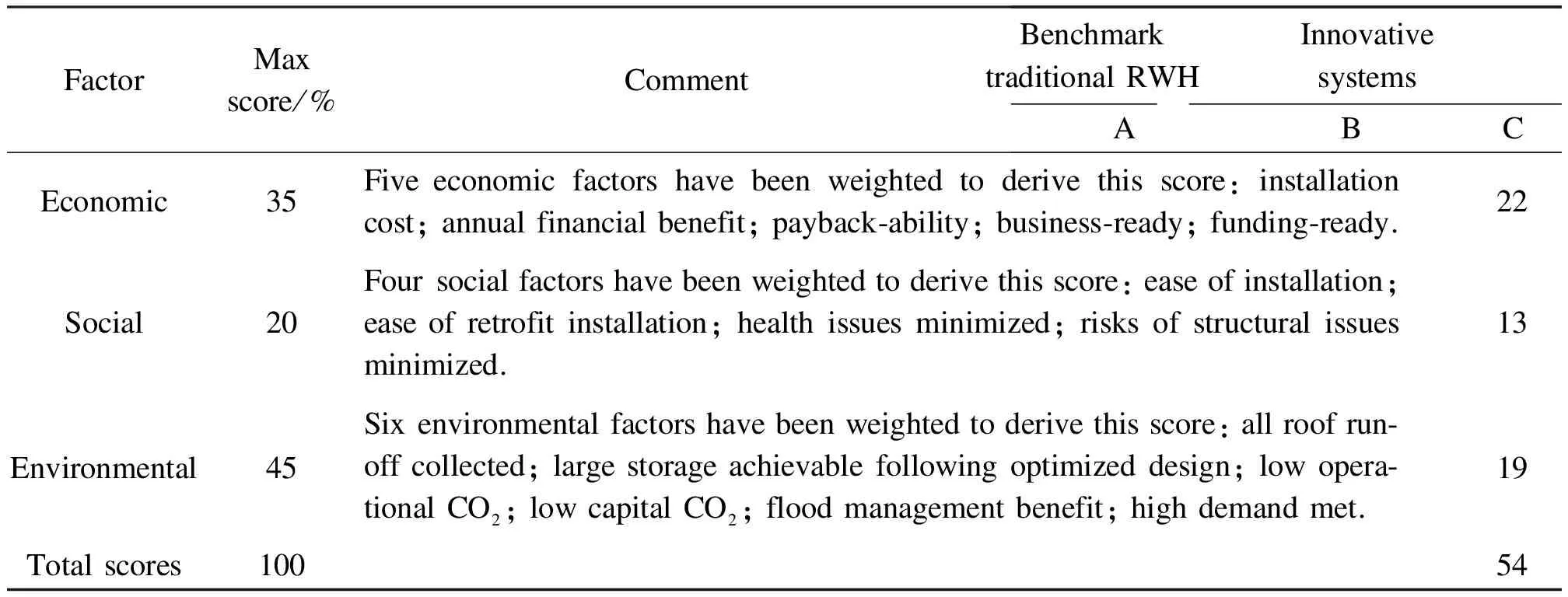
Tab.2 Results of MCA for 2 innovative against 1 traditional RWH system
Through reviewing each RWH system against the criteria set out in an evaluation matrix, a series of scores can be defined to allow the positive and negative aspects of each system to be identified. The method allows for a simple appraisal of each system to be undertaken without the need for developing prototypes and undertaking more detailed data driven assessments. The MCA process set out has been designed to permit extension of the results through assessing a wider range of products as new systems are developed.
4 Results
4.1 Patent application search
The patent application search identified 20 RWH patent applications filed during the 5 year assessment period. Some applications have not been granted patents. A technical review was conducted for each application to establish which had the greatest potential to offer optimal RWH solutions to the UK market.
Two patent applications were identified as offering potentially beneficial technologies for application in the UK RWH market. The UK patents numbered GB2449534 and GB2480834 have consented to their inclusion in this paper.
4.2 Flushrain: loft based RWH system
The Flushrain RWH system is illustrated below in Fig.2. The Flushrain system utilises a small roof-space mounted suction pump and storage tank[23]. The suction pump is attached to a series of collection cartridges which are mounted near the top of each rainwater downpipe as illustrated in Fig.2. During a rainfall event, these cartridges fill with water and each triggers a float switch. Once all of the cartridges have been filled, the single pump activates and draws water via small hoses from each cartridge into the loft tank.
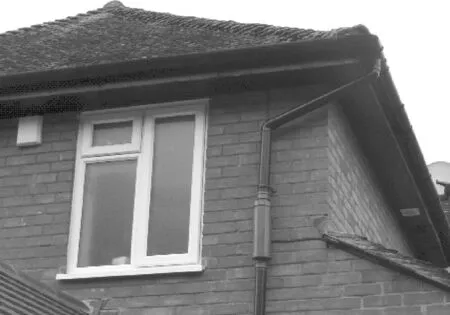
Fig.2 Flushrain’s collector
Flows pass through a sponge-based filter media and into a series of storage tanks which can be connected to provide the desired storage volume. An overflow and appropriate potable water top up valve are also situated in the tank. Water is then available to be plumbed to the WC’s, laundry or for external use. For the purposes of appraisal, the system is assumed to have a 1 m3storage capacity.
4.3 Aqua harvest and save: loft based RWH system
The aqua harvest and save RWH system is illustrated in Fig.3. This system utilises one or more, small gutter mounted pumps. The pumps are low cost, use minimal energy and deliver low flow rates. Each pump is mounted within a sump in the gutter immediately upstream of the downpipe. An open-air filter gauze covers each pump to prevent ingress of large debris. During rainfall, when the sump fills, the pump activates and lifts flows into the loft via small pipework hoses. A small header tank is provided to collect the water and a series of storage tanks are incorporated along the length of the roof to store the collected rainwater. An overflow and potable water top up are also incorporated. Water is then available to be plumbed into the WC’s, laundry or for external use. For the purposes of appraisal, the system is assumed to have a 1 m3storage capacity.
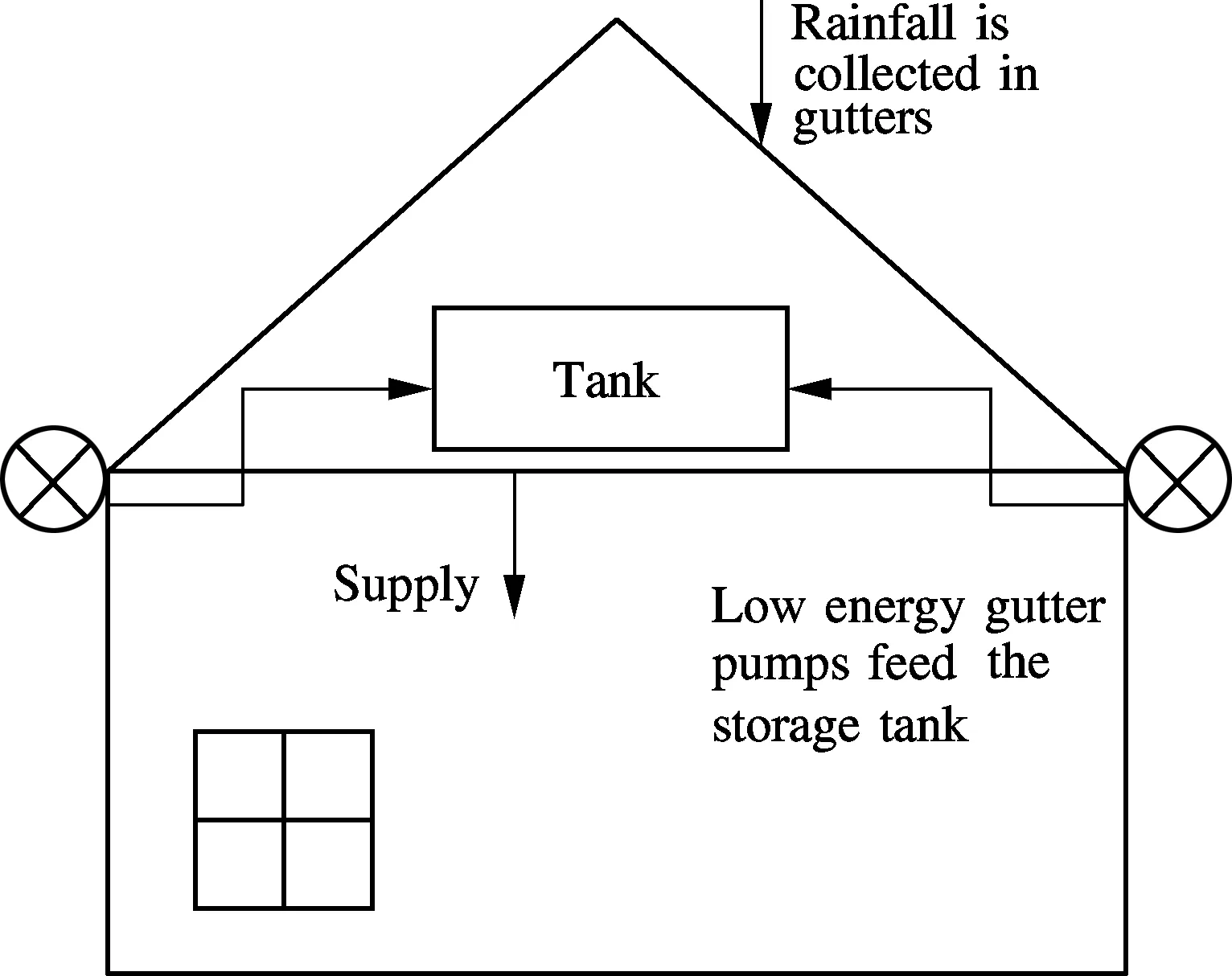
Fig.3 Illustration of aqua harvest and save RWH system
4.4 Informal interviews and cost assessment
4.4.1 Traditional RWH system capital cost assessment
The traditional RWH systems considered had a range of storage volumes and thus manufacturing and installation costs. RWH systems with larger storage volumes increase the purchaser’s surety of water during long periods without rain. Consequently, the larger storage systems can provide higher benefits. However, this must be considered as a trade-off against the increased capital outlay. Comprehensive design advice is available in BS8515: 2009[3]and useful design software is available in the form of raincycle[20].
The capital costs quoted include an allowance for delivery and installation. For the purposes of this assessment the following installation costs have been assumed for all traditional RWH systems as set out in Tab.3.
Tab.3 Estimated installation costs for traditional RWH systems

Storagevolume/m3Installationcosts/GBP0to21300>21800
The assumed installation costs have been based on the information provided during discussions with each RWH company. They are likely to represent an overestimate of new build installation costs which have been quoted as low as 300 GBP/property. However, these costs are likely to represent a reasonable lower-estimate for retrofit installations. These are generally considered to cost more than one times the cost of the manufactured units. Installation costs for each innovative RWH system have been compiled through an assessment of the time taken to install each component and the assumption that a skilled installer would charge 150 GBP/day.
A series of eight traditional RWH harvesting systems have been considered, two from each RWH company contacted. The lowest cost option has been identified as a 1 m3system with an estimated installed cost of 2 653 GBP. This system will be used as a benchmark to compare against innovative systems.
4.4.2 Innovative RWH system—capital cost assessment
The innovative systems selected for consideration in this paper differ from a traditional RWH system as they are designed to provide a low cost, simple technology with loft-based storage and no below ground tanks. Consequently, the storage achieved for these innovations is not expected to exceed 1 m3. Evidently the overall storage volumes will be subject to structural constraints in actual installations. Both innovative RWH systems are at a prototype-stage, consequently only one pilot installation of each has been constructed. To date, neither system is being monitored.
Through liaison with each patent holder and a review of the cost of the components required for constructing each system, an overall installation cost has been estimated based on the below items:
• Manufacturing: Header tank, pump(s), external pipework, internal pipework, filters, controls and electronics, other.
• Transport: Delivery cost, other logistics costs.
• Installation (including labour): On site construction, electronics/controls, external drainage, plumbing, commissioning, other.
The estimates shown in Tab.4 are established for the innovative RWH systems in comparison with the traditional benchmark system.
Tab.4 Comparison of capital costs for existing benchmark and innovative RWH systems

RWHsystemCapitalcost/GBPBenchmark:1m3traditionalRWHsystem—SystemA2653Innovative1m3RWHSystemB1035Innovative1m3RWHSystemC835
Fig.4 illustrates the notable differential in price between the systems. It is estimated that the innovative systems would cost just 31% and 40% of the benchmark RWH system price.
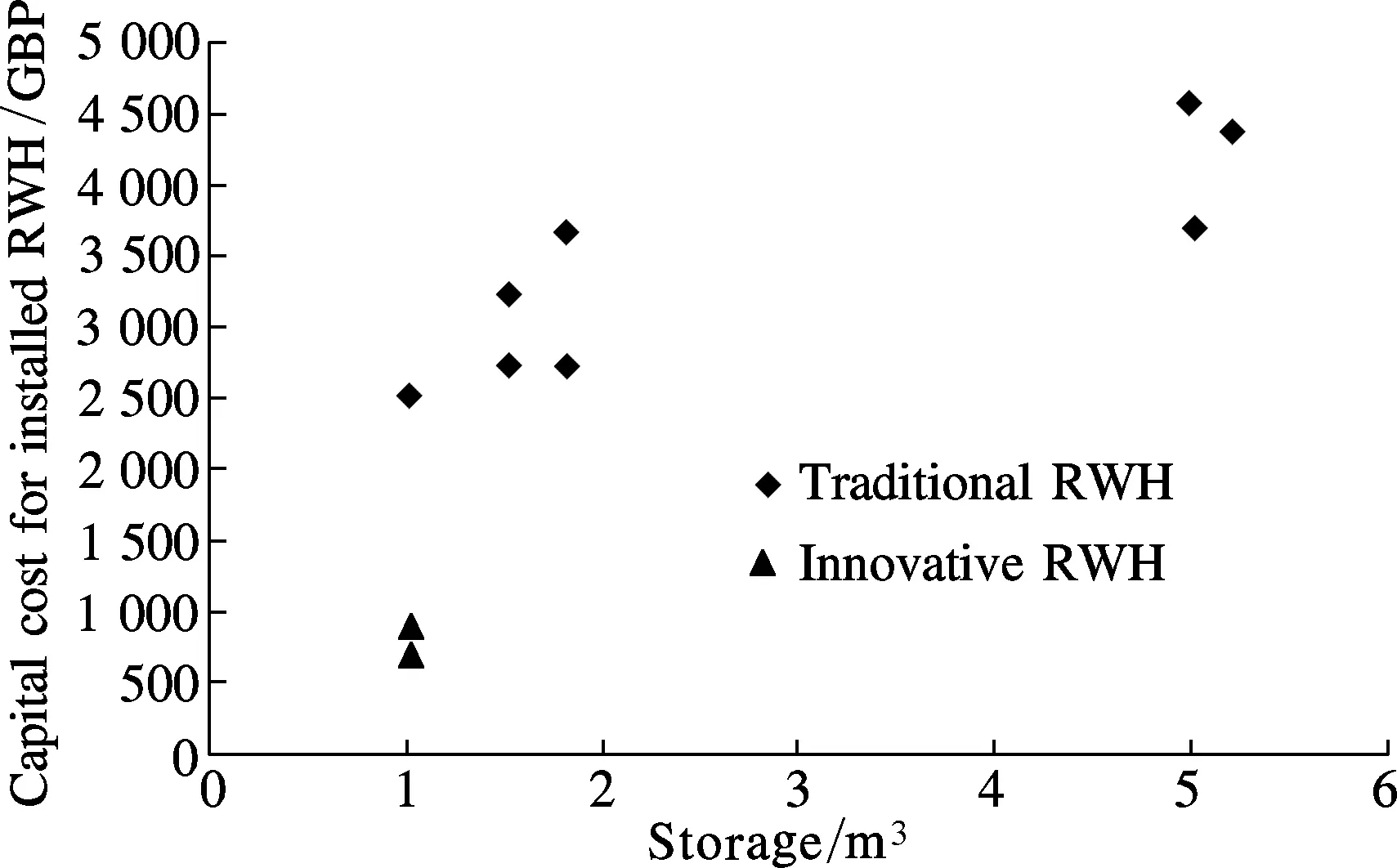
Fig.4 Estimated capital costs of innovative and traditional RWH systems
4.4.3 Multi criteria analysis
A summary of the MCA for the two innovative and one traditional RWH system is included in Tab.2. The last three columns of Tab.2 set out the scores for the three RWH systems. These have been developed through assessing each system against a sustainability scoring criteria using an evaluation matrix.
In developing the above matrix, the authors have derived a weighting for each criteria. As this is a simple MCA, the weights have been based on those factors deemed to be most important following a review of the existing market. Each scoring criterion has been weighted with a maximum value of either 5% or 10% giving a maximum score for an optimal RWH system of 100%. This assessment indicates that both the innovative RWH systems exhibit greater environmental and social characteristics than the traditional RWH systems.
4.5 Discussion
This study identifies that a range of drivers have led to the development of innovative technologies for the UK RWH market. The results indicate that the innovative RWH approaches could have lower capital costs than existing RWH technologies. In addition, when compared with a traditional 1 m3RWH system through a MCA, they are found to score more highly in terms of their overall sustainability credentials. However, several key factors must be considered in relation to these findings. Firstly, the costs for the traditional systems are likely to be negotiable, particularly if large orders are made. In comparison, the cost estimates for the innovative RWH systems are based on the authors’ assessment of the installation and manufacturing costs assuming installation costs are minimized and economies of scale are achieved.
The installation costs for the innovative systems are assumed to be much lower than the traditional systems as no excavation or external groundworks are required. This is found to be a major contributing factor. As a result, it is considered likely that, subject to their availability, the innovative systems would potentially be able to be installed at a lower capital cost than a traditional RWH system. The innovative systems are anticipated to have a lower capital and operational carbon footprint than the traditional RWH systems. These are two of the notable factors which have contributed to the innovative systems scoring more highly than the traditional RWH systems when assessed using the simple MCA.
It is considered appropriate to extend this study to conduct detailed WLC and LCA assessments in order to more fully assess whether the innovative systems provide an equivalent standard of service when compared with the traditional systems. Existing proto-types for the innovative systems will need to be monitored to allow their benefits to be further defined. Finally, due to the roof space based location of all stored water, it is noted that the main limitation of the innovative systems is their limited overall storage capacity.
As identified previously, one key factor will be to ensure that the innovative RWH systems can be easily retrofitted and that the structural risks associated with large volumes of water stored within loft tanks are clarified before installations take place. A series of trials are planned to monitor; water use, sewer flows, energy use and water quality in order to consider the wider benefits of installing the innovative RWH systems. Traditional systems will also be monitored to permit direct comparison. Once this data has been acquired, the assumptions set out in the MCA can be verified and the benefits of further developing innovative RWH systems for the UK market can be appraised in more detail.
5 Conclusion
This paper has identified the capital cost for installing a range of traditional RWH systems. In comparison, two innovative systems have been identified following a review of the UK’s patent website. The estimated capital costs of the innovative solutions have been found to be lower than currently available RWH systems for the residential retrofit market. It is considered likely that subject to their availability, the innovative systems could be installed at a lower capital cost than a traditional RWH system. The innovative systems have been compared with the traditional systems through implementing a simple multi criteria analysis. The result of this initial assessment suggests that the innovative systems score more highly relative to the traditional RWH systems in terms of their overall sustainability credentials.
It is evident that detailed appraisal of low or no energy RWH systems should be investigated further. It is concluded that further investigation in the form of WLC analysis and LCA of the innovative RWH concepts identified in this study warrant further quantified assessment. Ultimately this extension to the study should be designed to enable a detailed like-for-like comparison to be made with the traditional RWH approach through monitoring of pilot installations.
[1]MTW Research.Rainwaterharvestingmarketresearch&analysis[M]. MTW Research Publishing House, 2010.
[2]Ward S, Barr S, Butler D, et al. Rainwater harvesting in the UK: socio-technical theory and practice [J].TechnologicalForecastingandSocialChange, 2012, 79(7): 1354-1361.
[3]British Standards Institute.Rainwaterharvestingsystems—CodeofpracticeBS8515: 2009[M]. London: Copyright BSI, 2009.
[4]DCLG.Codeforsustainablehomes[M/OL]. (2010)[2013-05-02]. https://www.gov.uk/government/uploads/system/uploads/attachment_data/file/5976/code_for_sustainable_homes_techguide.pdf.
[5]DCLG.Costanalysisofthecodeforsustainablehomes[R/OL]. (2008)[2013-05-02]. http://www.rbkc.gov.uk/pdf/63%20Cost%20Analysis%20of%20the%20Code%20for%20Sustainable%20Homes%20July%202008.pdf.
[6]Severn Trent.Charges,customerinformation[M/OL]. (2012)[2013-05-02]. http://www.stwater.co.uk/upload/pdf/Scheme_of_charges_2012.pdf.
[7]Kellagher R. Stormwater management using rainwater harvesting: testing the Kellagher/Gerolin methodology on a pilot study, Report SR 736 [R]. Wallingford,UK: HR Wallingford, 2011-07.
[8]Fenn C. Some reflections on how we can plan for and respond to scarcity of public water in England & Wales[C]//CentreforWaterSystemsIRISeminar. Exeter, UK: University of Exeter, Centre for Water Systems, 2013: 10-11.
[9]Waterwise. Action for the river Kennet and Thames Water—care for the Kennet [M/OL]. (2013)[2013-04-05]. http://www.waterwise.org.uk/data/Documents/WEA_2012_Case_Studies/Care_for_the_Kennet.pdf.
[10]Elkington, J.Enterthetriplebottomline.Thetriplebottomline:doesitalladdup[M]. London: EarthScan, 2004.
[11]Murphy J M, Sexton D M H, Jenkins G J, et al.UKclimateprojectionssciencereport:climatechangeprojections[M]. Exeter, UK: Met Office Hadley Centre, 2009.
[12]HMRC.Corporationtaxrates[M/OL]. (2013)[2013-04-04]. http://www.hmrc.gov.uk/rates/corp.htm.
[13]DEFRA.Enhancedcapitalallowance(ECA)schemeforwater.Watertechnologycriterialist[M/OL]. (2012)[2013-05-02]. https://www.gov.uk/government/uploads/system/uploads/attachment_data/file/69605/pb13830 - eca-wtl-criteria-list.pdf.
[14]Mankad A, Tapswuan S, Greenhill M P, et al. Motivational indicators of decentralized systems use among householders in south east Queensland, Technical Report No.44 [R]. Urban Water Security Research Alliance, 2011.
[15]Brundtland H.Thereportofthebrundtlandcommission,ourcommonfuture[M]. London: Oxford University Press, 1987.
[16]Butler D, Memon F. Water consumption trends and demand forecasting techniques [C]//WaterDemandManagement. London: IWA Publishing, 2006: 1-26.
[17]Wackernagel M, Rees W E. Our ecological footprint, reducing human impact on the earth [J].EnvironmentandUrbanization, 1996, 8(2): 216-216.
[18]Hardie M. Rainwater storage gutters for houses [J].Sustainability, 2010, 2(1): 266-279.
[19]Environment Agency.Positionstatement—theuseofrainwaterharvestingsystems[M/OL]. (2011)[2013-06-10]. http://www.environment-agency.gov.uk/research/library/ position/131546.aspx.
[20]Roebuck R M, Oltean-Dumbrava C, Tait S. Whole life cost performance of domestic rainwater harvesting systems in the United Kingdom[J].WaterandEnvironmentJournal, 2011, 25(3): 355-365.
[21]Urrutiaguer M, Lloyd S, Lamshed S. Determining water sensitive urban design project benefits using a multi-criteria assessment tool[J].WaterScienceandTechnology, 2010, 61(9): 2333-2341.
[22]DCLG.Multi-criteriaanalysis:amanual[M/OL].(2009)[2013-06-03]. https://www.gov.uk/government/uploads/system/uploads/attachment_data/file/7612/ 1132618.pdf.
[23]FlushRain.Rooflocatedrainwaterharvesting[M/OL]. (2009)[2013-05-02]. http://www.flushrain.co.uk/.
对英国住宅区域几种新型雨水收集利用系统的初步可持续性评估
Peter Melville-Shreeve Sarah Ward David Butler
(Centre for Water Systems, University of Exeter, Exeter, EX4 4QF, UK)
由于缺乏对住宅雨水收集利用(RWH)系统类型的创新,在英国日常生活中的雨水收集利用还不是很广泛.介绍了一系列传统和新型的住宅RWH系统的初步研究结果, 并对这些RWH系统进行了研究,研究方法包括:专利申请搜索、对行业专家的非正式访问、成本效益分析和简单的多准则分析法(MCA).然后基于社会优先、经济优先和环境优先的标准,研究了这些系统的可持续性.其中,对2种新型的RWH系统进行了更为详细的分析,并与传统的RWH系统进行对比.多准则分析法结果表明,创新型系统在更少的资金消耗下,可持续性绩效要高于传统系统.进一步的研究重点在于模拟这些被鉴定的系统来产生经验性数据库,并应用于WLC/LACs,寻找设备安装中可能出现的挑战和问题.
创新; 多准则分析法; 雨水收集利用; 住宅区; 可持续性; 节水效率
TU991
Severn Trent Water and the EPSRC as part of the STREAM Engineering Doctorate Program.
:Peter Melville-Shreeve, Sarah Ward, David Butler. A preliminary sustainability assessment of innovative rainwater harvesting for residential properties in the UK[J].Journal of Southeast University (English Edition),2014,30(2):135-142.
10.3969/j.issn.1003-7985.2014.02.001
10.3969/j.issn.1003-7985.2014.02.001
Received 2013-10-30.
Biography:Peter Melville-Shreeve (1985—), male, graduate, pm277@exeter.ac.uk.
猜你喜欢
杂志排行
Journal of Southeast University(English Edition)的其它文章
- Prediction on effectiveness of road sweepingfor highway runoff pollution control
- Approach to estimating non-point pollutant load removal rates based on water environmental capacity: a case study in Shenzhen
- Potential contributions to Beijing’s water supply from reuse of storm- and greywater
- Characteristics of Hg pollution in urban stormwater runoff in Nanjing city, China
- Rainwater harvesting in the challenge of droughts and climate change in semi-arid Brazil
- Practice and analysis of recycling non-drinking waterfrom air-condition and reverse-osmosis systeminto rainwater collection system
